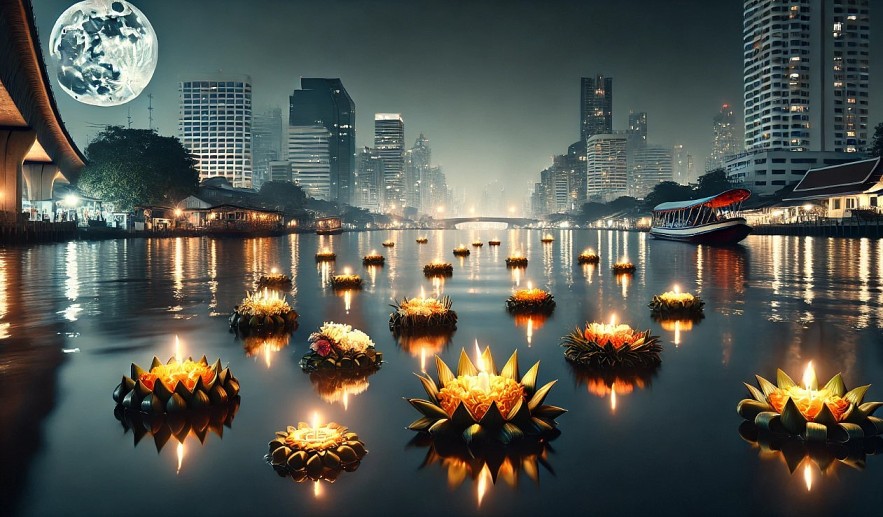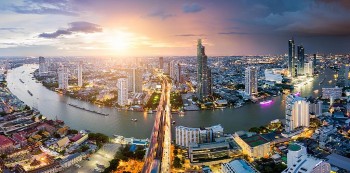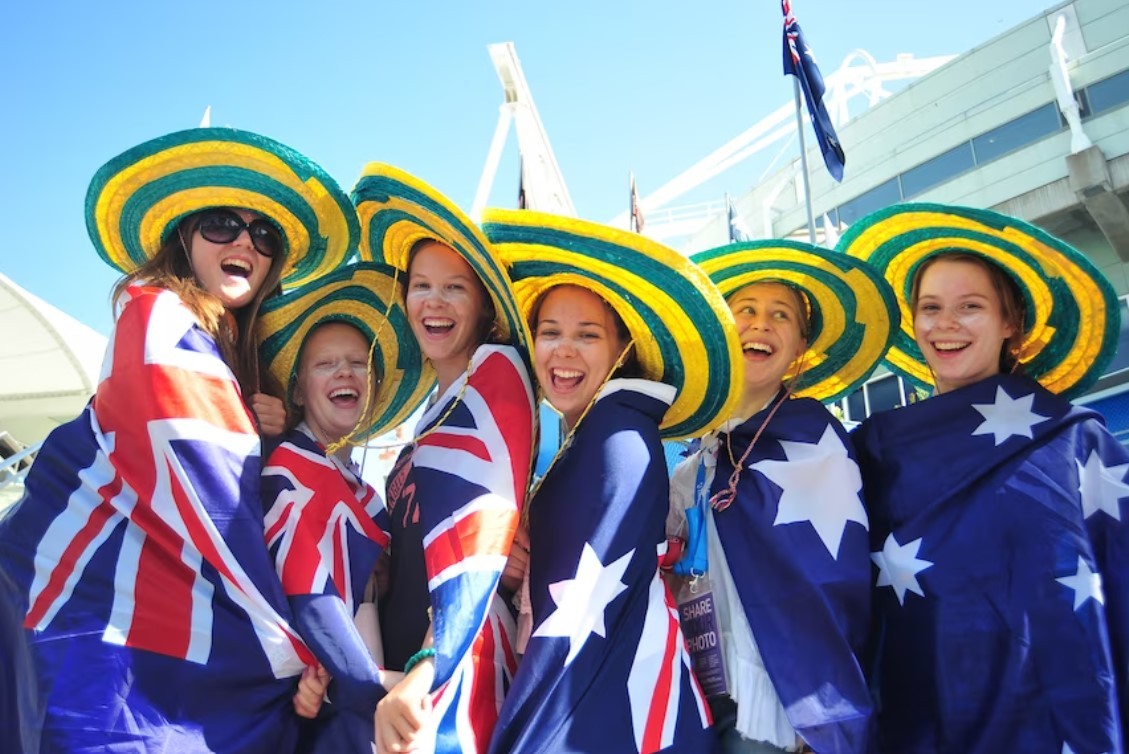Loy Krathong Festival - Origin, Significance, And Celebrations Across Thailand
| Table of Contents |
Loy Krathong, one of Thailand’s most enchanting and culturally significant festivals, captivates both locals and visitors alike each year. Known as the "Festival of Lights," it typically falls on the full moon night of the 12th lunar month, usually in November. Loy Krathong is a time for people to gather by rivers, lakes, and ponds to release floating decorations called krathongs onto the water, symbolizing a release of negativity and an invitation for blessings.
 |
| Loy Krathong festival scene on a river. Illustration: Knowinsiders/AI |
The Origins of Loy Krathong
The exact origins of Loy Krathong are somewhat mysterious, with historians offering various theories about its beginnings. Some believe it originated as a Brahmin ritual from India that made its way to Thailand, while others argue that it is linked to ancient Thai water festivals.
The festival has also been associated with Buddhism, as it is believed that releasing a krathong into the water serves as a tribute to the Buddha, expressing gratitude to the water goddess Phra Mae Khongkha, and symbolizing the washing away of past sins. Regardless of its origins, the festival has become a unique celebration that reflects Thai beliefs, spirituality, and reverence for water.
 Thailand Calendar in 2025 - Full List of Public Holidays, Observances And Celebrations Thailand Calendar in 2025 - Full List of Public Holidays, Observances And Celebrations |
Cultural Significance
Loy Krathong holds deep cultural and spiritual significance for Thai people. The term "Loy" means "to float," while "Krathong" refers to the small, buoyant container usually made from banana leaves, decorated with flowers, incense, candles, and often a small coin. The act of releasing a krathong onto a body of water is seen as an act of gratitude and respect for the water goddess. It is also believed to symbolize letting go of anger, hatred, and grudges, allowing participants to start afresh with a clear heart and mind.
The celebration highlights Thailand's connection to nature, especially water, which plays a vital role in Thai agriculture and daily life. The festival is a reminder of the importance of preserving natural resources and respecting the environment, values that remain strong in Thai culture.
The Making of a Krathong
One of the most beautiful aspects of Loy Krathong is the creation of the krathong itself. Traditionally, krathongs are crafted from natural materials such as banana leaves, banana tree trunks, and flowers. The use of biodegradable materials reflects a respect for nature, which aligns with the festival’s purpose of honoring the water goddess. In recent years, however, non-biodegradable krathongs made of foam or plastic have sometimes appeared, leading to environmental concerns. Many Thai communities are now advocating for a return to traditional, eco-friendly materials to protect the waterways.
A krathong typically contains a candle, three sticks of incense, and flowers like marigolds, lotus, or jasmine. People may also add a few strands of hair or fingernail clippings as symbolic representations of letting go of the negative aspects of oneself. Some add small coins as an offering to the water goddess, hoping for good fortune in return.
Celebrations Across Thailand
Loy Krathong is celebrated with enthusiasm throughout Thailand, with different regions adding their own unique touches. Here are some popular destinations and variations of the festival:
Chiang Mai’s Yi Peng Festival
In northern Thailand, particularly in Chiang Mai, Loy Krathong is combined with the Yi Peng Lantern Festival, creating a breathtaking spectacle. During Yi Peng, people release paper lanterns, known as khom loi, into the sky, symbolizing the release of misfortunes. The sky fills with thousands of lanterns, creating a magical display. The combined festivals of Loy Krathong and Yi Peng make Chiang Mai one of the most popular destinations for tourists during this time.
Sukhothai Historical Park
As the ancient capital of Thailand, Sukhothai is believed to be the birthplace of Loy Krathong. The Sukhothai Historical Park, a UNESCO World Heritage Site, hosts a grand celebration featuring traditional dance performances, music, fireworks, and, of course, krathong floating. This historic location enhances the atmosphere, allowing visitors to experience Loy Krathong in a setting reminiscent of ancient Thailand.
Bangkok’s Chao Phraya River
In the bustling city of Bangkok, Loy Krathong takes place along the Chao Phraya River, where locals and tourists gather to release krathongs and enjoy the vibrant festivities. Many hotels and restaurants along the river offer Loy Krathong events, providing excellent views of the river and skyline.
Phuket’s Beach Celebrations
Loy Krathong celebrations in Phuket are held on various beaches, with people releasing krathongs into the Andaman Sea. The festival here is marked by a laid-back, coastal atmosphere, and many tourists join the locals in releasing their krathongs into the ocean waves.
Activities and Events During Loy Krathong
Aside from releasing krathongs, the festival is filled with activities and events that bring communities together. Here are some of the highlights:
Krathong-Making Competitions: Many communities host contests to see who can create the most beautiful and intricate krathong. These competitions highlight the skill and creativity involved in krathong-making and encourage the use of eco-friendly materials.
Beauty Pageants: Known as Noppamas Queen Contests, these beauty pageants are named after Noppamas, a legendary figure believed to be the first person to float a krathong. Participants dress in traditional Thai attire, and the contest celebrates beauty, grace, and the cultural traditions of Loy Krathong.
Traditional Dance and Music: Performances of classical Thai dance and music are common during the festival, providing an immersive cultural experience for attendees. Traditional Thai instruments, such as the khim and ranat ek, fill the air with melodies that enhance the enchanting atmosphere.
Fireworks: Many cities and towns celebrate Loy Krathong with fireworks, illuminating the night sky and adding to the festival's vibrant atmosphere.
Modern Loy Krathong and Environmental Concerns
In recent years, Loy Krathong has faced some challenges related to environmental sustainability. With the popularity of the festival growing, the number of krathongs released each year has increased, sometimes leading to pollution in rivers and lakes. Non-biodegradable materials like foam and plastic have contributed to environmental issues, as they do not decompose naturally and harm aquatic ecosystems.
To address these concerns, Thai authorities and environmental groups are promoting the use of natural materials for krathongs. Some initiatives encourage people to make their own krathongs from biodegradable materials, while others suggest using virtual or symbolic krathongs instead of physical ones. These efforts aim to preserve the beauty and significance of Loy Krathong while ensuring that it does not harm the environment.
Experiencing Loy Krathong as a Visitor
For travelers, Loy Krathong offers a unique opportunity to witness Thailand's rich cultural heritage. To fully experience the festival, visitors can participate in krathong-making workshops, explore local markets selling festival items, and join the evening ceremonies by the water. Chiang Mai and Sukhothai are highly recommended for those seeking a traditional Loy Krathong experience, while Bangkok and Phuket provide a modern twist on the celebration.
When attending Loy Krathong, it is essential for visitors to respect Thai customs and traditions. Dressing modestly, especially in temples or during religious ceremonies, is a sign of respect. Additionally, tourists are encouraged to follow the environmental guidelines and use eco-friendly krathongs.
Conclusion
Loy Krathong is more than just a festival; it is a celebration of Thailand's spiritual connection with nature, water, and light. By releasing krathongs onto the water, people honor the water goddess, let go of negativity, and start anew. The festival’s unique blend of beauty, spirituality, and communal joy makes it one of Thailand’s most cherished traditions. As Loy Krathong continues to evolve with environmental awareness, it remains a testament to the enduring beauty of Thai culture and its harmonious relationship with nature.
Whether you are a first-time visitor or a local resident, participating in Loy Krathong is a magical experience, offering a glimpse into Thailand’s cultural heart.
FAQs about Loy Krathong
1. When is Loy Krathong celebrated?
Loy Krathong is celebrated on the full moon night of the 12th lunar month in the Thai calendar, which usually falls in November.
2. What is the purpose of Loy Krathong?
Loy Krathong is a time to pay respect to the water goddess, Phra Mae Khongkha, by releasing krathongs onto the water. It symbolizes the release of negativity and past misfortunes, allowing for a fresh start.
3. What materials are used to make a krathong?
Traditionally, krathongs are made from natural, biodegradable materials like banana leaves, banana tree trunks, and flowers. These materials are environmentally friendly and decompose naturally in water.
4. Can I make my own krathong?
Yes! Many communities and markets offer krathong-making workshops, especially around the festival period. You can craft your own krathong with flowers, incense sticks, and candles for an authentic experience.
5. Are there any environmental concerns with Loy Krathong?
In recent years, environmental issues have arisen due to non-biodegradable krathongs made of foam or plastic. Efforts are underway to promote eco-friendly materials, with some festivals encouraging symbolic or virtual krathongs to protect waterways.
6. What’s the difference between Loy Krathong and Yi Peng?
While both are celebrated around the same time, Loy Krathong involves floating krathongs on water, while Yi Peng, mainly celebrated in northern Thailand (especially Chiang Mai), focuses on releasing sky lanterns. The two festivals are often celebrated together in Chiang Mai, creating a visually stunning event.
7. Where is the best place to experience Loy Krathong?
Popular places include Chiang Mai (for the combined Loy Krathong and Yi Peng festivals), Bangkok (along the Chao Phraya River), Sukhothai Historical Park (a traditional setting with historical significance), and Phuket (celebrations along the beach).
8. Do I need to dress in traditional clothing for Loy Krathong?
While traditional Thai attire adds to the experience, it is not required. However, it’s respectful to dress modestly, especially if attending ceremonies in temples or other sacred areas.
9. Is Loy Krathong a national holiday in Thailand?
No, Loy Krathong is not a public holiday, so offices and schools generally remain open. However, it is widely celebrated across the country, with many people participating in the evening festivities.
10. Can tourists participate in Loy Krathong?
Absolutely! Tourists are welcome to join in, whether by releasing their own krathongs, attending events, or simply observing. It’s a beautiful way to experience Thai culture firsthand.
11. What should I avoid doing during Loy Krathong?
Out of respect, avoid using non-biodegradable materials in your krathong, littering near water sources, and wearing revealing clothing in temple areas. Also, be mindful of the local customs and respect the environmental guidelines for the festival.
12. Are there any specific customs associated with releasing a krathong?
Many people say a small prayer or make a wish before releasing their krathong. Some also include a coin as an offering to the water goddess. For many, releasing the krathong is a deeply personal and spiritual moment, so it’s best to observe quietly and respectfully.
 Top 10 Most Popular and Famous Cosmetic Brands In Thailand Today Top 10 Most Popular and Famous Cosmetic Brands In Thailand Today As Thailand is home to well-known cosmetic brands in the world, it is rather hard to select the best brands. In this article, we will ... |
 Top 10 Largest Companies In Thailand By Market Cap (2024 Update) Top 10 Largest Companies In Thailand By Market Cap (2024 Update) Thailand has made extraordinary progress in social and economic development during the last four decades, rising from a low-income to an upper-middle-income country in less ... |
 Where Is Prostitution Legal In Thailand Today? Where Is Prostitution Legal In Thailand Today? In Thailand, there has long been disapproval towards sex workers. To learn more about Thailand's laws regarding prostitution, read this article! |
 Top 12 Biggest Shopping Malls/Retail Centers In Thailand Top 12 Biggest Shopping Malls/Retail Centers In Thailand Thailand is known as Asia's best place to shop. If you go to Thailand, you should make sure you check out any of those best ... |


























